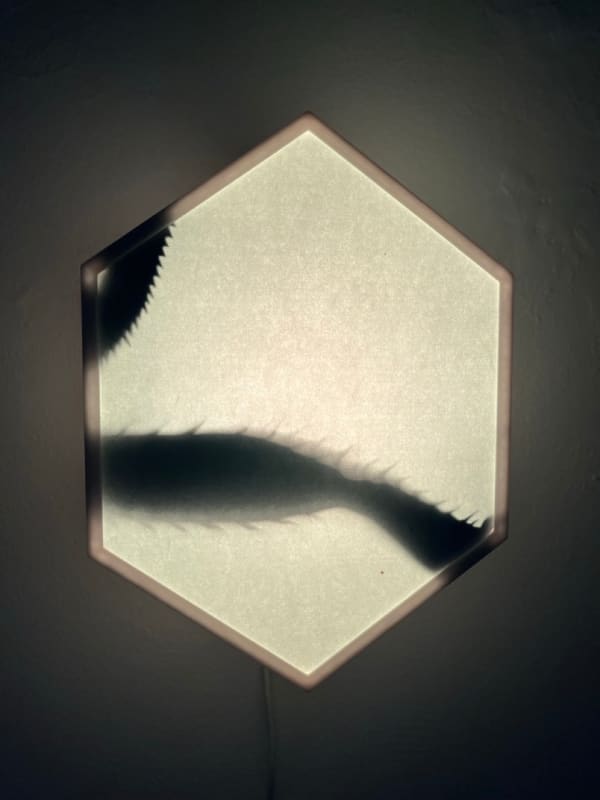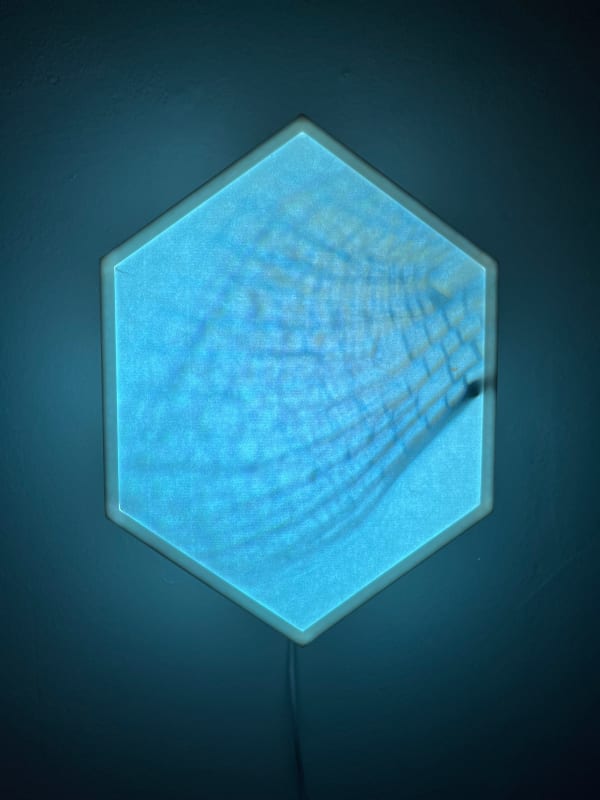Kat Austen
作品
-

-

-

-

-
 Kat AustenHow to touch a dragonfly, 2023-4Wall-mounted Relief Sculptures Comprising: Aluminium, LEDs, Electronics, Laser-Cut Hanji, 3D Printed PLA, Video and Sound
Kat AustenHow to touch a dragonfly, 2023-4Wall-mounted Relief Sculptures Comprising: Aluminium, LEDs, Electronics, Laser-Cut Hanji, 3D Printed PLA, Video and Sound
"When I was a child, there were dragonflies everywhere." This recollection opens How to Touch a Dragonfly, an immersive installation that unfolds at the intersection of memory, ecological change, and technological vision. The installation brings together traditional Korean craft, cutting-edge media, and deep ecological research to create a sensorial environment where visitors are invited to experience the world through the perspective of a dragonfly—an ancient, migratory insect now profoundly impacted by anthropogenic transformation.
At the core of the installations is the concept of a low-resolution screen composed of individual hexagonal “pixels” that echo the lenticular structure of the dragonfly’s eye, playing a narrative video and soundscape exploring landscapes changing due to human actions. These pixels are created by video-mapped LEDs shining through folded Hanji—handmade Korean paper crafted for the piece by artisans at the Jeonju Millennium Hanji Museum. The result is a visual system that resists high-definition spectacle, favouring embodied intimacy and fractured vision. Visitors step into a world that translates motion, colour and vibration as dragonflies might experience it.
Juxtaposing Cheongsan Island, a farming area designated a Globally Important Agricultural Heritage Site, with urban spaces in Republic of Korea, the work explores the relationships between land use, climate change and insect migration. It draws on interviews with elders from Cheongsan Island and field recordings of dragonfly habitats, weaving together past and future, memory and data, emotion and environmental change.20 x wall mounted sculptures: 15 x 20 x 10cm
large wall-mounted relief sculpture: 1.5m x 90 cm x 15cm
传记
My artistic practice explores the shifting boundary between self and other to reimagine our relationship with society and the environment amid ecological crisis. I interrogate how empathy, agency, identity, and power are formed through our entangled existence with more-than-human and non-human others.
Working primarily with new media, I create technically complex, research-intensive works that span sound, musical composition, sculpture, installation, performance, and digital media. Sound is a central to my artworks: I build instruments that translate chemical and physical phenomena into sonic expression, make field recordings, and engage in embodied research to cultivate deep connection with the species, landscapes or materials at the heart of each project.
Each artwork is grounded in rigorous transdisciplinary research, integrating insights from environmental science, philosophy, and cultural theory. I lead diverse teams working across disciplines through non-hierarchical, networked modes of collaboration. My practice involves not only developing new ideas but architecting the frameworks, tools, and systems required to realise them.
Currently, I am focussing on two intertwined themes: the possibility of recovery from environmental and social catastrophes through reconfiguring human-environment relationships, and the ethical and aesthetic implications of artificial intelligence. In the latter case, I develop new methods of creating datasets and training AI, exploring how algorithmic systems might be redirected toward situated, ethical, and pluralistic forms of expression for environmental and social benefit.
While my work is deeply conceptual, it is also sensorial, emotional, and political. I consider the self as a minded body, and use rhythm, flow, and embodied experience as tools for sensing interconnectedness. My artworks are beautiful and emotive, offering new ways of knowing and relating, foregrounding aesthetics as a means of engaging with urgent environmental and sociopolitical concerns.
I employ participatory and open-source methodologies such as DIY science, artistic research, and creative technology to contribute to the community of practice, to promote peer knowledge sharing and to expand the reach and resonance of my research. These approaches invite diverse audiences to connect with and contribute to the evolving discourse my work inhabits.
My projects are built to be multi-layered, intellectually and technically ambitious, and emotionally charged. The works challenge the status quo and invite visitors to reimagine how we live together on a damaged planet.
Working primarily with new media, I create technically complex, research-intensive works that span sound, musical composition, sculpture, installation, performance, and digital media. Sound is a central to my artworks: I build instruments that translate chemical and physical phenomena into sonic expression, make field recordings, and engage in embodied research to cultivate deep connection with the species, landscapes or materials at the heart of each project.
Each artwork is grounded in rigorous transdisciplinary research, integrating insights from environmental science, philosophy, and cultural theory. I lead diverse teams working across disciplines through non-hierarchical, networked modes of collaboration. My practice involves not only developing new ideas but architecting the frameworks, tools, and systems required to realise them.
Currently, I am focussing on two intertwined themes: the possibility of recovery from environmental and social catastrophes through reconfiguring human-environment relationships, and the ethical and aesthetic implications of artificial intelligence. In the latter case, I develop new methods of creating datasets and training AI, exploring how algorithmic systems might be redirected toward situated, ethical, and pluralistic forms of expression for environmental and social benefit.
While my work is deeply conceptual, it is also sensorial, emotional, and political. I consider the self as a minded body, and use rhythm, flow, and embodied experience as tools for sensing interconnectedness. My artworks are beautiful and emotive, offering new ways of knowing and relating, foregrounding aesthetics as a means of engaging with urgent environmental and sociopolitical concerns.
I employ participatory and open-source methodologies such as DIY science, artistic research, and creative technology to contribute to the community of practice, to promote peer knowledge sharing and to expand the reach and resonance of my research. These approaches invite diverse audiences to connect with and contribute to the evolving discourse my work inhabits.
My projects are built to be multi-layered, intellectually and technically ambitious, and emotionally charged. The works challenge the status quo and invite visitors to reimagine how we live together on a damaged planet.






